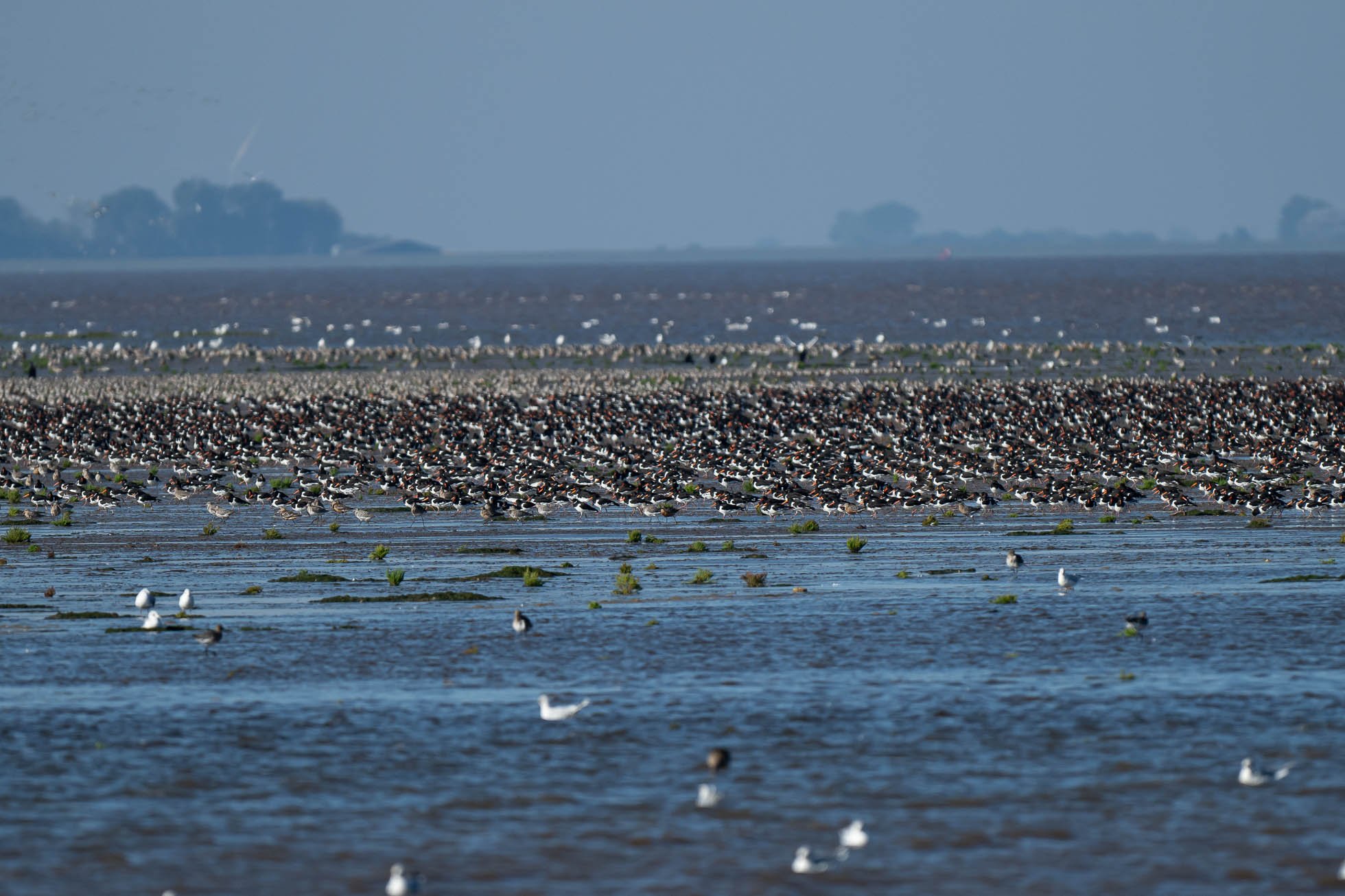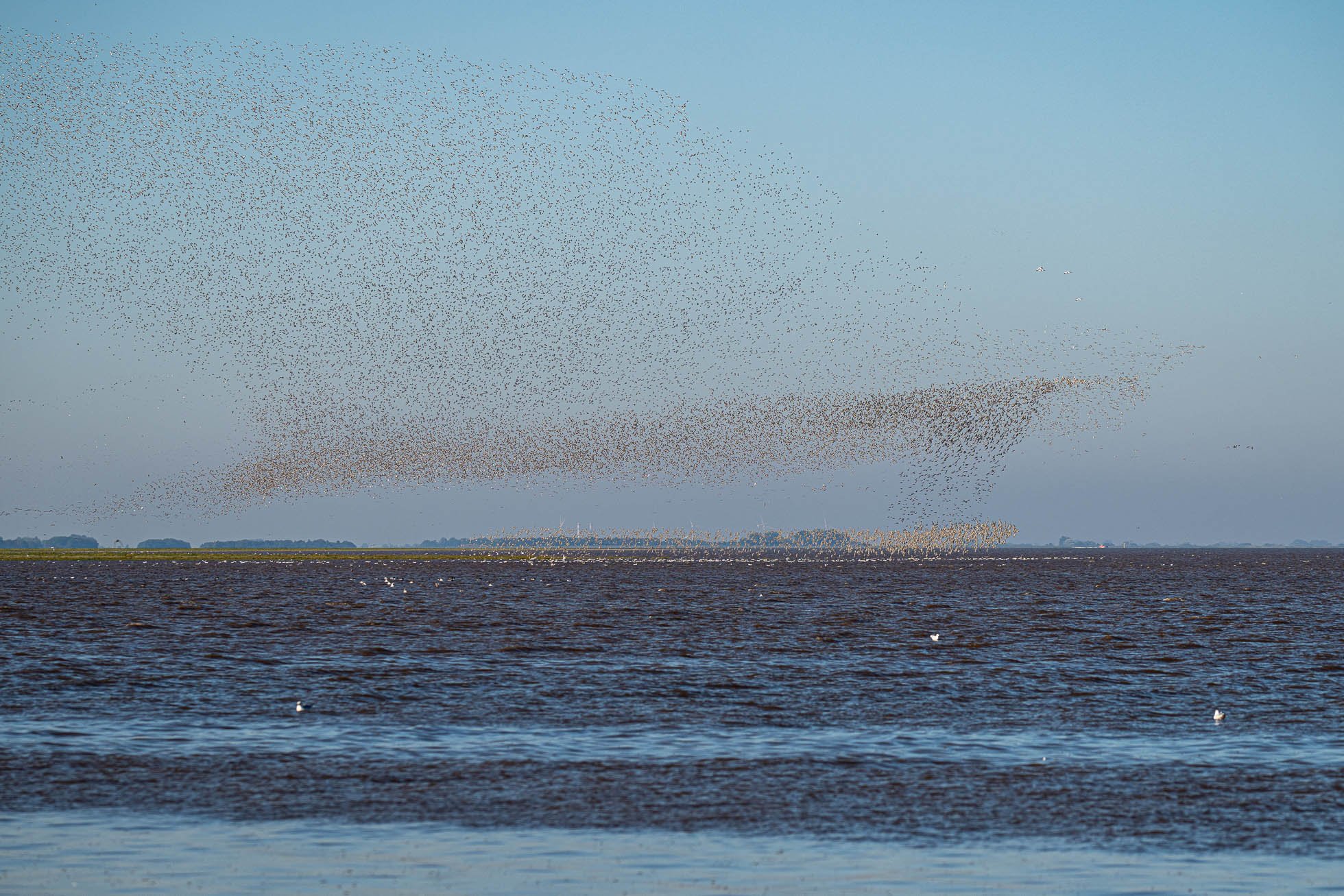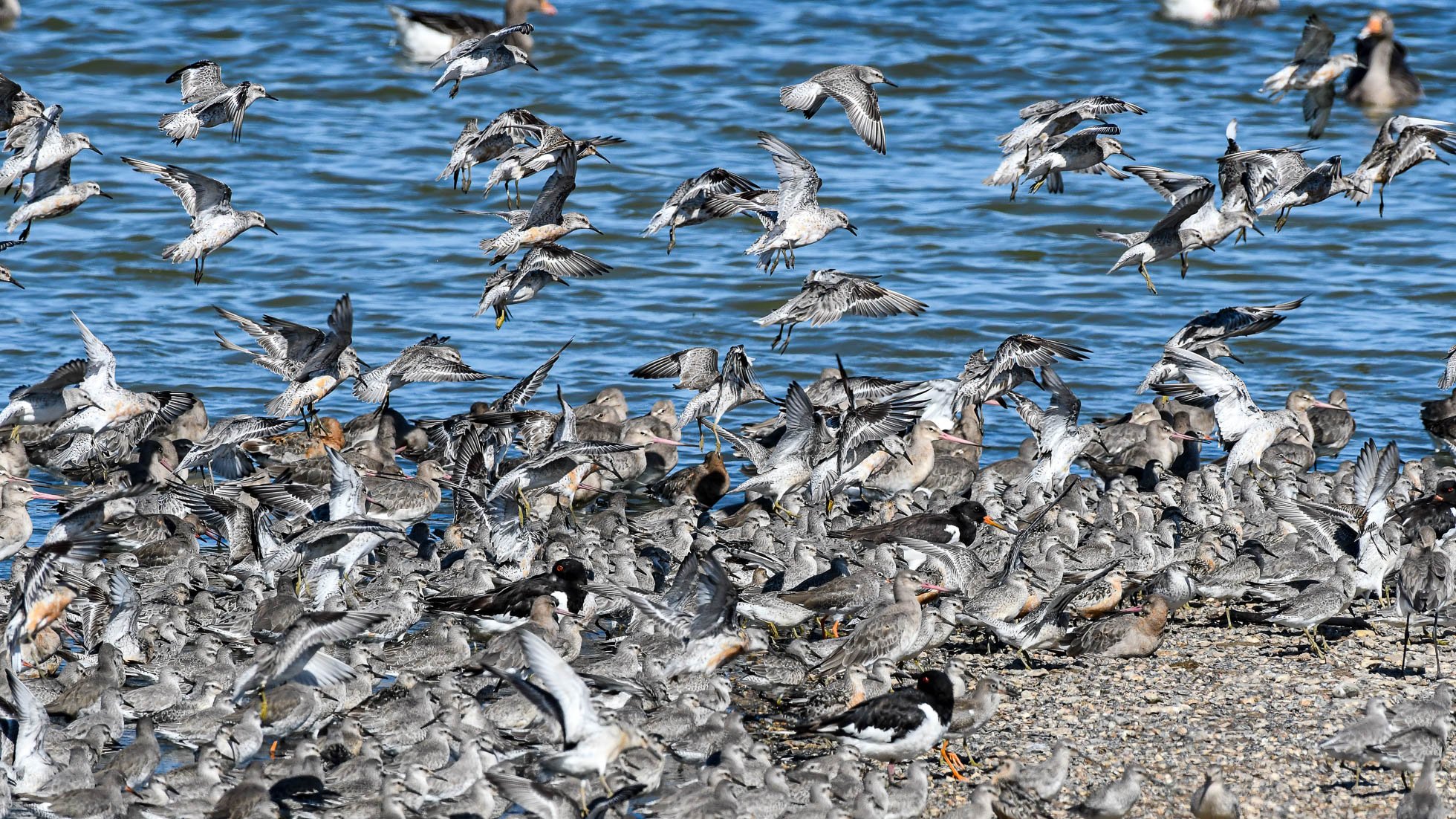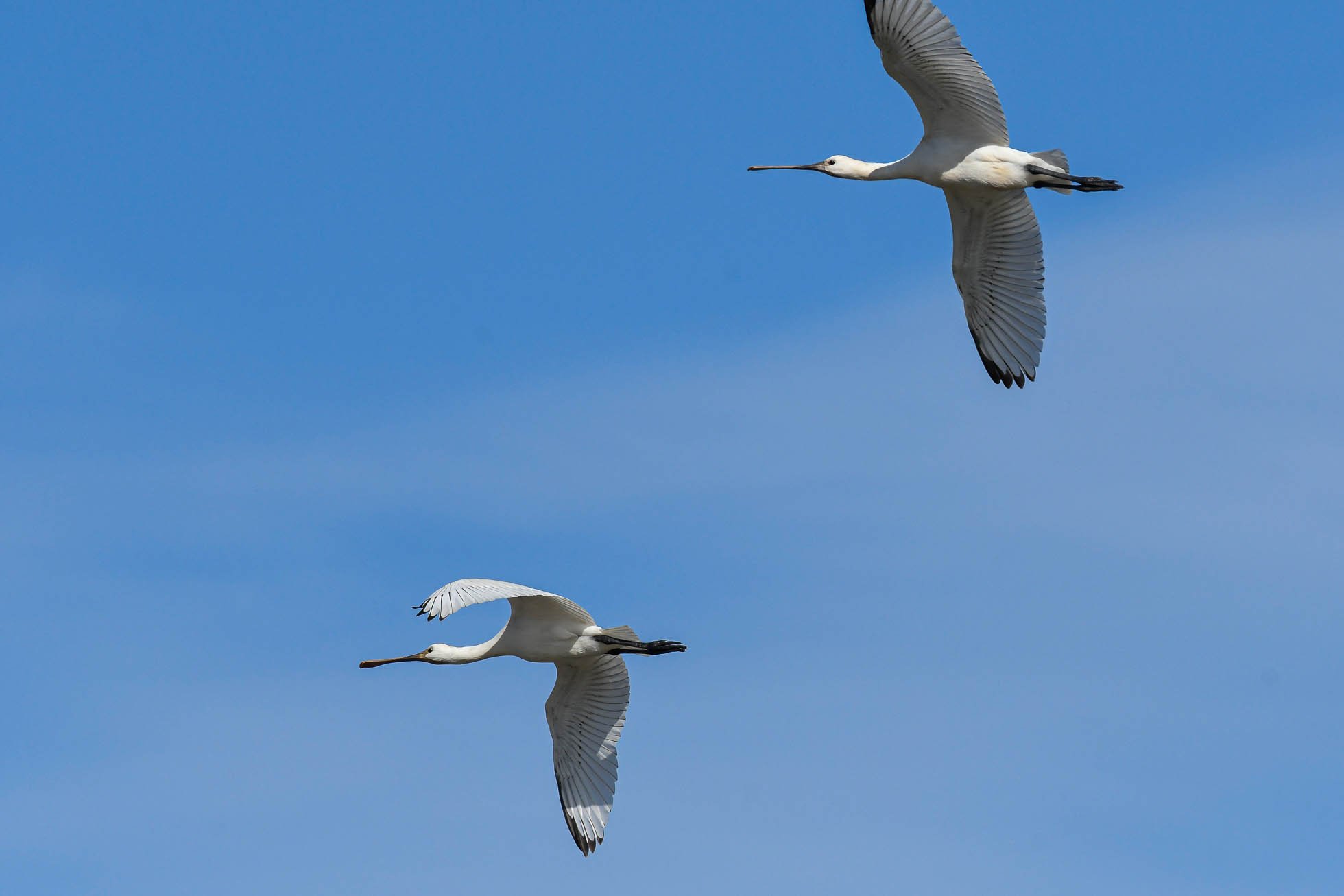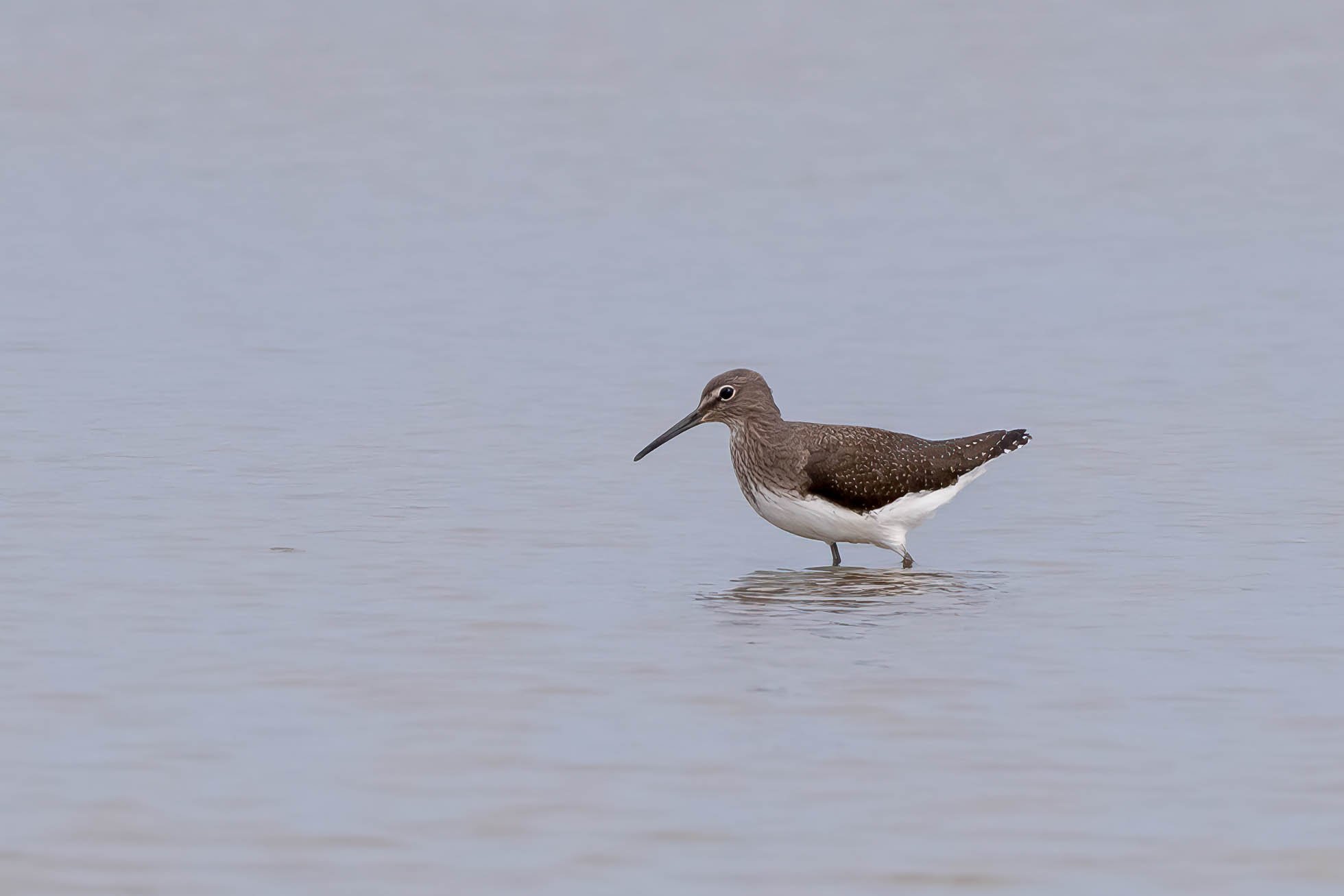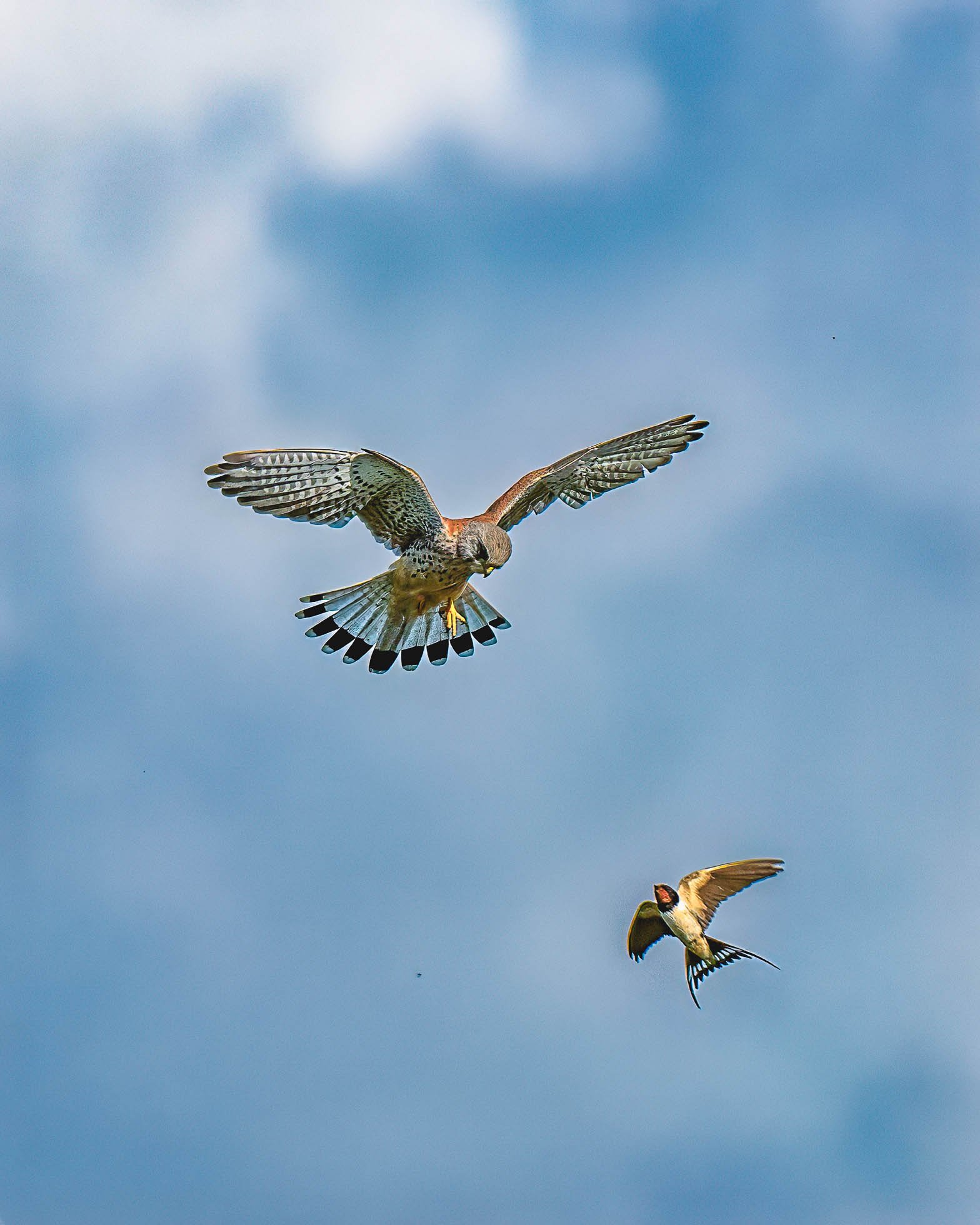September started with some glorious weather. An extremely high tide in Norfolk in the first week of the month tempted us to RSPB Snettisham to see the Wader spectacular. The high tides this time of the year force the waders off the mud flats in the Wash, and onto the mainland for a while. There are thousands of birds all taking to the skies together. The high tide on the morning we decided to go was at a respectable time of 10.00 am. As it turned out we were not the only ones with the same idea and the area was full of like minded birdwatchers. Luckily it is a large reserve with plenty of room for everyone without upsetting the wildlife. A very social gathering where we met old acquaintances and made new ones. We really are a very friendly lot.
If you want cafe, shop and visitor centre then dont expect this at Snettisham. The RSPB have kept the reserve basic and wild. Expect a long walk so take your own refreshments, and “spend a penny” before you go.
The water is approaching fast and the birds start to out run the tide at first. Its best to arrive before the peak of the high tide. If however, you arrive when the tide is completely out, you will be disappointed. The mudflats stretch out across to Lincolnshire, and the birds will be too far away to see.
The tide is high and off they go. Mostly Knot, Bar Tailed Godwits, Redshanks and Oyster Catchers.
The breath-taking moment when thousands of birds fly in front of you and over your head, all calling to each other, and the swish of their wings as they pass nearby just makes you gasp. This show is free, what more could you ask for. Wildlife is wonderful.
Some move further down the coast looking for a place to land.
The lagoon area with a few hides is a great place to watch the waders land as they arrive from their feeding grounds out on the mudflats.
A large flock of Redshanks resting, waiting for the tide to turn when they can return to mud to feed.
Spoonbills flying in to rest. Once very rarely seen, Spoonbills are now regular visitors to our wetlands. The lagoons held a group of approximately 15 birds.
Smaller waders such as Ringed Plovers can be seen along the shoreline. They are quite close and do not seem to mind everyone around.
Try and take in everything the reserve has to offer, not just the birds. Lots of Bees were along the sandy bank by the path on the way to the hides. Not really sure what these are, probably a type of mining bee. Not sure what was happening here either, possibly a queen underneath the group.
The walk out to the reserve takes you past several fishing lakes. A Cormorant was struggling with an Eel he had caught. The tussle went on for quite a while and the Eel, proving to be the slippery customer they are famous to be, finally got away.
It had been a good day, but now it was turning very hot. While a breeze had kept the temperature bearable on the coast, the hedgerows kept the footpath sheltered but not shady and the walk back was exhausting. The car park, again whilst being protected by hedgerows and shrubs was open to the full sun. The car was like an oven. We decided it was too busy and hot for any further birdwatching .( Birds are far more sensible than us and stay in the shade when its hot.) It was best to head for home, stopping off for a picnic lunch in the cool of the woods at Sandringham on the way back and getting home by late afternoon. Time for a cold cider and a nap, in that order.
What better place to spend hot days than at the cool peaceful fishing lakes near home. Not Norfolk today.
Late September found us back in Norfolk, this time for a week. We were based at Kelling Heath, just round the corner from Cley. We chose the only week in September that promised rain and gale force winds. As it turned out it wasn’t too bad at all and we managed to dodge most of the bad weather, although thunder storms and branches clonking down onto the caravan roof a couple of nights was interesting.
Fallow Deer at Holkham Hall estate.
A beautiful male Fallow Deer. He will soon be fighting for his ladies.
The boys meeting up for “A Stag Do”
Whilst taking in the view with a cup of coffee from the small car park at Stiffkey Marshes, looking for any Harriers that may be around, a Wall butterfly, thought to be so called because of its love of basking on walls and stones, landed on the footpath post. This is a little brown butterfly we have seen before but have not managed to get a picture. It insisted on resting with its wings closed, so we still have not managed to get a picture with wings open. Still very pretty markings though.
The tide was out a Morston quay so a walk to check for any waders was in order. Little Eva dog remained on the lead as she seemed intent on getting down into the mud.
A Curlew enjoying searching the mud banks for food at Morston Quay.
Norfolk rushes and reeds
You just never know what is going to drop in on the scrapes at Cley marshes, so its worth just sitting in the hides and scan the area with your binoculars. This time it was a Green Sandpiper.
So, two of the waders we always find difficult to identify. Dunlin at the front and Curlew Sandpiper at the back.
How lovely was this to sit and watch. A family of Swallows had nested in one of the hides and the adults were backwards and forwards feeding the young. Occasionally, the youngsters ventured out for a short flight but were soon back in again. These birds were obviously used to people and we spent a lovely half hour being entertained by these beautiful little birds. Its incredible to think that they will soon be making the long flight back to Africa. The return journey to Africa takes about six weeks. Swallows from different parts of Europe fly to different destinations. Ours end up in the very south. They travel down through western France and eastern Spain into Morocco, before crossing the Sahara Desert and the Congo rainforest – finally reaching South Africa and Namibia. Safe journey little ones.
So close to the swallows in the hide.
Photographing a Kestrel and got photobombed by one of the Swallows.
West Runton beach is ideal for all fossil hunters and is part of the Norfolk deep History Coast. While we were there the tide was out and large groups of school children were in the Rock Pools, looking to see what they could find. The Steppe mammoth skeleton was discovered on this beach. The best, and safest place to look for fossils here is around the rockpools and shingly parts of the beach at low tide
The Cromer Forest-bed is exposed here during scouring tides which is rich in fossils.
We were so lucky to spot a Young Peregrine falcon on the cliff.
A bit of a drive from where we were staying, Horsey Mill, and on the coast opposite, our destination, Horsey Gap to find the Atlantic Grey Seals.
We were not expecting to see many seals on the beach as it is a bit early in the year. What a surprise to find over thirty, mostly teenage Atlantic Grey Seals just chilling, along with a few little Harbour Seals. As the beach starts to fill up with pregnant seals in late October/early November, a voluntary beach closure is put in place by FoHS wardens. You can still access two great viewing areas on the top of the dunes from Horsey Gap car park. On the morning we went the beach was open and only a few people were sitting and watching seals. For more information about the Horsey Gap seals and the seals at Winterton on Sea see the website www.friendsofhorseyseals.co.uk.
A small Harbour Seal. The smaller of our two UK seal species, common seals are also known as harbour seals. So that’s something we didn’t know.
Not a care in the world.
The famous Happisburgh Lighthouse.
Happisburgh Time and Tide Bell
A giant bell that chimes when the tide comes in and goes out has been installed on the beach. Designed to be rung by the waves at high tide, Happisburgh's bell is one of 13 'Time and Tide' bells situated around Britain where at any given time one of the bells will be tolling. The timber frame holding the bell was made from a single oak tree planted in 1790 and felled in 2021, having captured within it carbon from all the years of the industrial revolution to the present day.
Dusk in Cromer from the pier.
Whilst everyone was heading for the show on the pier we went the opposite way to find a pub for a pie and a pint.
Cromer Pier.
A lovely day at Wells harbour.
The Lifeboat Horse, made from steel bars and whisky barrels, was created by artist Rachael Long as a tribute to the horses that once pulled the town’s lifeboat more than two miles from the quay to Holkham Gap
When the tide goes out at Wells, where is the sea.
Little Eva stretching her legs on Wells beach. It is such a great dog walking beach. Miles of firm flat sand, until the tide returns.
Last evening walk along beach road looking towards Cley Marshes.
Our last evening at Cley for a while and, despite the warm days there is an Autumn chill in the air as night draws in.
You will see in the background that the Pink footed Geese have returned for the winter . . . Their sound in the Norfolk sky signifies Autumn has arrived.


